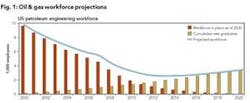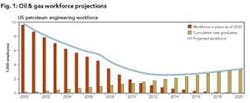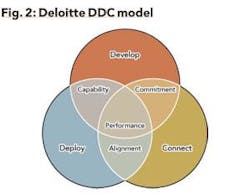Zeroing in on Generation Y: Deloitte’s approach to talent management
Mikaila Adams, Associate Editor, OGFJ
The October 2005 issue of Oil & Gas Financial Journal included an article about the looming shortage of professionals in the energy industry. As many in the industry know, 60% of today’s experienced oil and gas managers are expected to retire in the next 5 to 10 years, threatening vital institutional knowledge. Companies not prepared for this shortage will risk future growth.
The OGFJ article looked at the problem from both an academic and industry perspective - the role of universities in attracting students, as well as the role of oil and gas companies in retaining skilled employees and attracting new graduates.
It comes as no surprise that many companies are looking into the problem. Researchers at Deloitte Consulting LLP, including Rekha Sampath, a manager in Deloitte Research, and Mark Robinson, an energy analyst with Deloitte Touche Tohmatsu, have closely studied the problem and have zeroed in on one particular sector - attracting and engaging Generation Y. Generation Y is the industry’s newest resource and is comprised of those born between 1982 and 1993. Deloitte Research has recently published this study entitled, “The Talent Crisis in Upstream Oil & Gas: Strategies to Attract and Engage Generation Y.”
According to this study, there is still a problem with diminishing enrollment in petroleum engineering and geosciences programs. An important predictor regarding the future supply of oil and gas employees is the number of students obtaining university degrees in these areas. As Fig. 1 shows, fewer than 1,000 US students are projected to graduate from such programs in 2006. This is more than a 90% drop since 1982.
Reasons for the decline in enrollment in these programs include perceptions that the industry offers: 1) short-term jobs versus careers; 2) few attractive opportunities at junior levels; 3) tenure-based advancement versus meritocracy; and 4) little work/life balance. In order to avert a damaging workforce shortage, company leaders need to understand the unique values Gen-Y holds, and then formulate and execute strategies to recruit, develop, and engage this new resource.
Focus on Generation Y
Upstream oil and gas companies should reexamine their mechanisms for communication with Gen-Y, namely their branding and identity, organization roles, and rewards programs. Organizations will need to design unique approaches for each of these elements, or adopt existing successful practices from leaders within the upstream sector and other areas of the industry.
This section suggests specific tactics for corporate branding, roles, and programs that communicate the company’s commitment to each of the Gen-Y workplace needs identified previously (long-term career development, sense of purpose/meaning in work, mentors, work/life flexibility, tech-savvy work environment, open social networks), as well as to the values that underlie them: flexibility, balance, respect, feedback, and access to people, tools, and technologies (See Table, p.12). Underlying each mechanism is Deloitte’s “Develop-Deploy-Connect” philosophy for talent management.
Click here to view the table in PDF.
The researchers feel that Deloitte’s “Develop-Deploy-Connect model” (Fig. 2) is one method worth looking into when developing an organization’s talent strategy. By focusing on these three elements, they believe organizations can generate capability, commitment, and alignment in key workforce segments, which in turn improve business performance. When this happens, the attraction and retention of skilled talent largely take care of themselves.
Generally, employers can ‘develop’ their workers by providing them with active learning opportunities, ‘deploy’ them by designing effective organizational environments, and ‘connect’ them by creating infrastructure to foster collaboration.
Develop
Deloitte defines “develop” as providing the real-life learning employees need to master a job. Just as important as traditional classroom or online education are the “trial-by-fire” experiences that stretch their capabilities and the lessons they learn from peers, mentors, and others.
The development portion of the process provides rich experiences, builds international networks, coaches and mentors employees, and creates targeted learning. The value in this approach is that is makes for a shorter learning curve, enables faster decision-making and better strategic execution, as well as engaging employees and providing greater flexibility and responsiveness. In order for this phase to be successful there must be a clear link to business strategy and leadership accountability.
Deploy
The “deploy” phase means working with key individuals to (a) identify their deep-rooted skills, interests, and knowledge, (b) find their best fit in the organization, and (c) craft the job design and conditions that help them to perform. This phase is designed to help people find their niche. It supports self-directed performance and builds a “risk-tolerant” mindset.
It is also designed to help build predictive modeling for emerging needs. By doing so, optimism, determination, enthusiasm, and drive are all increased. This reduces the cost of disengaged employees, reduces turnover, and thus, reduces training costs. To be successful, strategies and goals must be communicated. Information must be in place to connect employees to the right jobs. The focus must be on critical segments and the employers must also focus on the potential of the employees.
Connect
Finally, the “connect” phase provides critical employees with the tools and guidance they need to (a) build networks that enhance individual and organizational performance, and (b) improve the quality of their interactions with others. In this phase, people are connected to ideas, other people, and a greater mission. This, in turn, creates intentional networks and improves the quality of interactions.
This phase is valuable because it increases performance in terms of decision-making and project execution. It improves learning and the flow of knowledge, and increases creativity and innovation.
Conclusion
The impending talent shortage, and potential resulting loss of institutional knowledge, has created an urgent need for companies in the upstream oil and gas industry to evaluate and update their approach to recruiting, developing, deploying, and connecting their people.
To replenish the workforce pipeline, such organizations must work to understand the values of the incoming generation, and then carefully rethink their strategies for attracting and engaging these young entrants. Furthermore, they must communicate their organizational philosophies through effective branding, role development, and rewards programs.
Deloitte delivers services in four professional areas, audit, tax, consulting, and financial advisory services, and serves more than one-half of the world’s largest companies, as well as large national enterprises, public institutions, locally important clients, and successful, fast-growing global growth companies. The subsidiaries of the US member firm are among the nation’s leading professional services firms, providing audit, tax, consulting and financial advisory services through nearly 30,000 people in more than 80 cities.OGFJ


